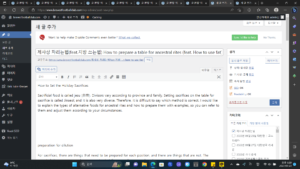How to Set the Holiday Sacrifices
Sacrificial food is called jesu (祭需). Divisors vary according to province and family. Setting sacrifices on the table for sacrifice is called Jinseol, and it is also very diverse. Therefore, it is difficult to say which method is correct. I would like to explain the types of alternative foods for ancestral rites and how to prepare them with examples, so you can refer to them and adjust them according to your circumstances.

preparation for dilution
For sacrifices, there are things that need to be prepared for each position, and there are things that are not. The ancestral rites may serve only one ancestor, but there are also cases where two or more ancestors are served at once. So, compared to a general table setting, there are things that need to be prepared by each individual, and there are things that are not. Food used in ancestral rites is called by special names, such as rice and soup.
1. Prepare for each rank
Rice (me), soup (gaeng), and sungnyung (suksu) are prepared according to the number of priests. Tteokguk or songpyeon replaces them on holidays.
Place the rice in a bowl and cover with a lid. For soup, beef radish soup is often used and the cover is covered. For sungnyung, dissolve a few grains of rice in cold or hot water.
2. Things that have nothing to do with the number of ranks
Alcohol (Jeju), vinegar (chojeop), soy sauce (cheongjang), rice cake (pyeon), stew (soup), pancake (jeon), grilled meat (red), po (fish po, jerky, etc.), sikhye (hye), seasoned herbs ( Sukchae), kimchi (chimchae), snacks, and fruits (fruits) are prepared regardless of the number of ranks.
The alcohol prepares a clear drink. Vinegar and soy sauce are prepared in the middle of the day. For rice cakes, sirutteok is usually used. Stew (tang) is made with fish soup, meat soup, chicken soup, etc. in odd numbers, or made with three ingredients at once. Pancakes are prepared with meat and fish pancakes.
For roasting, early fish, beef, and chicken are used. Po prepares fish poo, beef jerky, etc. In the case of fish po, the back is placed on top. Sikhye contains Sikhye ingredients. Three kinds of herbs of different colors are placed on one plate. Nabak kimchi is used for kimchi. Fruits are prepared in even numbers. All jesu are cooked with soy sauce and salt without using spices (garlic, pepper, red pepper powder, green onion).
How to set up a ancestral table
For the ancestral rites, the side where the deity is located is regarded as the north. Therefore, the side where Jeju is located is south, and when viewed from Jeju, the right side is east and the left side is west. Usually, the table is set in 5 rows, but if you look at the side with the divine stomach, rice and soup, which are meals, are served in the 1st row, grilled meat and jeon, etc., which are the main dishes of the ancestral rite, are served in the 3rd row, and the next dish is served in the 3rd row. In the fourth row, side dishes such as vegetables, kimchi, and pho are served, and in the fifth row, desserts such as fruits and snacks are served.
The ancestral rites are usually set in five rows. Prepare an incense burner, woolen bowl, and toeju bowl in front of the table.
Proverbs related to the setting of the sacrificial table
It is difficult to say in general because the way to set the table for ancestral rites varies from family to family and inevitably varies depending on the food prepared. Here are some of the proverbs related to setting the table for ancestral rites, so please refer to them.
– Gobihapseol (考妣合設): In the case of a husband and wife, the male ancestor and the female ancestor are prepared together.
– Sijeopgeojung (匙楪居中): The bowl containing the spoon is placed in the center in front of the Shinwi.
– Banseo-Geng-Dong (飯西羹東): Rice (me) is west and soup (gang) is east (opposite to living people)
– Jeokjeopgeojung (炙楪居中): Place the roast (red) in the center.
– Eodong Yukseo (魚東肉西): Place fish on the east side and meat on the west side.
– Dongduseomi (東頭西尾): Head to the east, tail to the west.
– Baebok direction (背腹方向): Grilled chicken or fish fillet is with the back facing upward.
– Seoseo Byeong-dong (麵西餠東): Noodles are placed in the west and rice cakes are placed in the east.
– Sukseosaengdong (熟西生東): Cooked greens are placed on the west side, and raw kimchi is placed on the east side.
– Seopo Donghae · Hye (西脯東醢·醯): Po is the west. Fish sauce and sikhye are placed on the east side.
– Hongdongbaekseo (紅東白西): Red fruits are placed on the east side, and white fruits are placed on the west side.
– Dongjo Seoyul (東棗西栗): Dates are placed in the east and chestnuts are placed in the west.